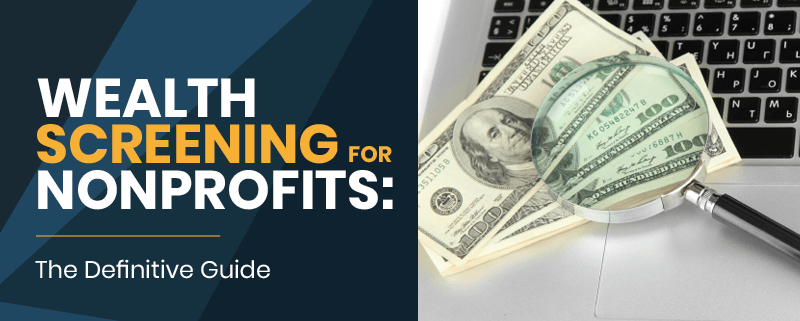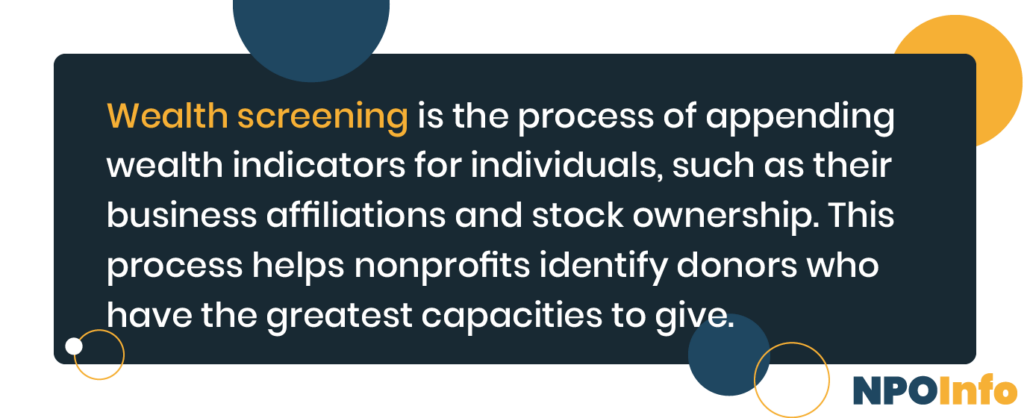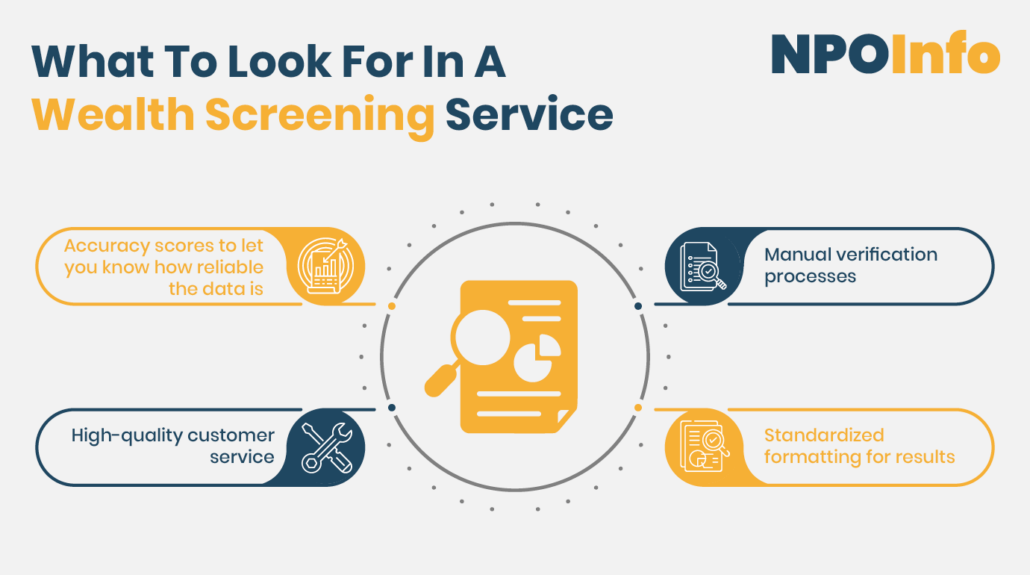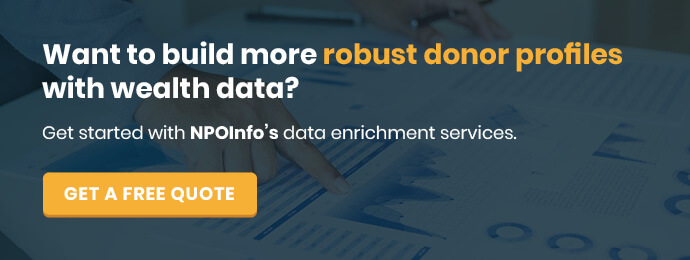Wealth Screening for Nonprofits: The Definitive Guide
As a nonprofit marketer, you strive to create meaningful, lasting supporter relationships, and data is a big part of that. Data-driven strategies can inform your cultivation strategies by letting you know who your donors are. In particular, wealth screening can help you determine how much someone can afford to give and how likely they are to donate to your cause based on past giving behaviors.
In a world driven by technology, donor data is more accessible and helpful than ever. You just need to know what information to collect, use the right tools to gather it, and then fold your results into your outreach strategies.
Whether you’re looking to fund a capital campaign with major gifts or level up your low- and mid-tier donors, wealth screening is a smart option. At the same time, it might seem daunting if you’re unfamiliar with the basics. This guide is here to help! So that you can tap into wealth screening, we’ll dive into these topics:
- What is wealth screening?
- How do nonprofits use wealth screening?
- What data should you receive through wealth screening?
- Tips to get more out of financial data appending
- Choosing wealth screening services
At NPOInfo, we work with all sorts of nonprofits to build robust donor profiles. With our data enrichment services, we can help you send more targeted fundraising asks and subsequently deepen donor relationships. By sharing what we know, we’re confident you’ll be equipped to leverage wealth screening at your nonprofit. Let’s get started!

What is wealth screening?
Wealth screening is the process of appending financial data and other wealth indicators for individuals. This process helps nonprofits identify and target prospective and existing donors with the greatest capacity to give.
Nonprofits using this service must share identifying information for individual supporters, such as their names and contact information. Then, their chosen nonprofit wealth screening service leverages public record data and propriety philanthropy databases to pull this information. When their file is returned, nonprofits can use the data to segment supporters into groups based on giving capacity and send targeted fundraising appeals.

How do nonprofits use wealth screening?
Guessing who your wealthiest donors are based on hunches or inaccurate data is a risky game. Wealth screening will guarantee that you’re working with accurate data, so you can make informed decisions when planning your fundraising campaigns.
With accurate wealth data, you’ll be able to focus your efforts on the right donors, honing in on those who are likely to make a big impact on your cause. So let’s take a look at four key ways you can fold this process into your everyday marketing and fundraising.
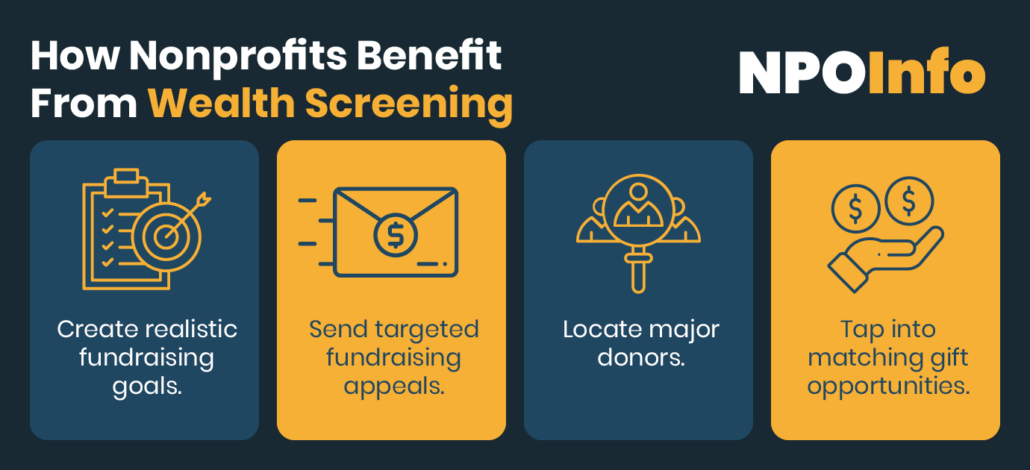
1. Create realistic fundraising goals.
At its core, donor wealth screening will let you know how much your donors can give. Based on this data, you can set realistic (yet still aspirational) fundraising goals to drive your campaigns to new heights.
Otherwise, you risk underestimating your team and setting goals that are too low. Then, when you reach your campaign’s goal, support may taper off as donors won’t feel as motivated to give if they don’t think you still need donations.
On the other hand, you also risk overestimating your team if you don’t have sufficient wealth data. You may set objectives that are too far-fetched, causing your team to feel deterred when you fall short.
2. Send targeted fundraising appeals.
A well-crafted fundraising appeal is comprised of four primary components:
- Who you’ll ask to donate
- When you’ll ask for a donation
- How you’ll ask for it
- The amount you’ll ask the donor to give
Data appending allows you to address each of these areas, resulting in a higher return on your investment. Alongside other donor data, wealth screening will help you understand the individual’s giving capacity. Then, you can pair that with their communication preferences and frequency, resulting in a well-timed ask completed with a reasonable amount.
That way, you don’t risk leaving money on the table by asking for too little or much. And as we’ll explore later, you can streamline your outreach further by grouping donors with similar giving capacities, saving even more time.
3. Locate major donors.
Your organization’s major donors are the life source of your work. They’re fully invested in your cause and devote a considerable amount of their hard-earned money to keep your doors open. Donorly’s guide to major donors explains that these individuals provide your cause with its largest, most impactful gifts.
About 80% of individual donor fundraising revenue comes from just 20% of your donors.
That being said, finding these donors and cultivating relationships with them should be a top priority for your team. Wealth screening gives you the information you need to uncover them and create outreach that resonates with them.
By uncovering donors’ current assets and past giving to similar organizations, you won’t waste your time trying to level up donors who aren’t likely to give any more to your cause than they already do.
4. Tap into matching gift opportunities.
Appending financial data can provide valuable employer data, letting you know where your donors work. From here, you can research their companies, flag any that offer matching gift programs, and follow up with anyone who might be eligible.
Around 26 million individuals work for companies with matching gift programs, but only 1.31% of individual contributions made to the average nonprofit are matched, according to Double the Donation’s fundraising statistics.
Knowing this, you likely have a few matching gift opportunities within your own CRM. By finding these opportunities, you’ll double (maybe even triple!) individuals’ contributions, multiplying their impact on your cause.

What data can you receive through wealth screening?
The type of data you’ll receive depends on your nonprofit wealth screening services provider. Pinpoint the type of information you need and then find a provider who can append that data for you. To maximize results, we recommend pairing philanthropic and wealth data, helping you find donors who can give and actually want to give to your cause.
Of course, there’s no limit on how much data you can collect, but there is a limit on how much you should collect! Several factors can point to a donor’s capacity for charitable giving, and some are more valuable than others. Let’s break down the most valuable types of data you might collect. That way, you won’t get buried under unnecessary data!
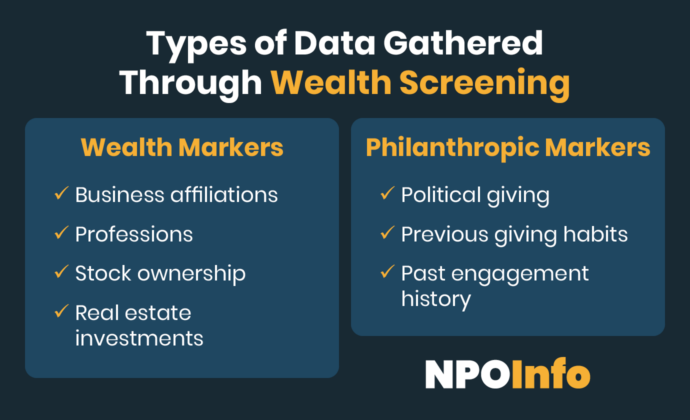
Wealth markers
When appending financial data, focus on these wealth indicators:
- Business affiliations. A donor’s business affiliations hint at their net worth and give insight into potential professional connections you can use for networking opportunities. This type of data includes business partnerships, a role on a board, and other types of corporate connections.
- Profession. Someone’s profession, along with other employer data, can help you estimate their salary and disposable income, which is especially useful if they’re in a high-paying field. You’ll need to know information like their city, job title, and company, so you can research average salaries in their career field and location.
- Stock ownership. Although these are typically liquid assets, stocks are a reliable wealth indicator that can be used to estimate prospects’ financial capacity. Start researching stock ownership by consulting portals like the one provided by the Securities and Exchange Commission (SEC), which maintains records on publicly traded companies.
- Real estate investment. The amount of money someone invests in real estate can point to their net worth and signal that they value opportunities to spend their money wisely. In fact, major giving research has found that individuals who own at least $2 million in real estate are 17 times more likely to donate to charity than the average person.
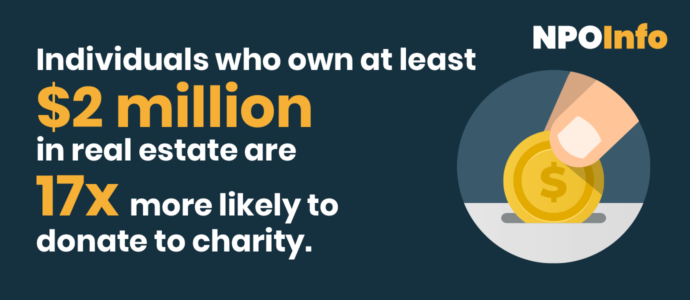
These wealth indicators will give you a solid foundation to launch your prospect research forward. While they’re not surefire proof of donors’ wealth, they can give you a pretty solid idea of it. Always use your best judgment when analyzing any wealth data and formulating it into your outreach strategies.
Philanthropic markers
While wealth indicators are certainly valuable, they’re not the only indicators of a donor’s giving capacity. Philanthropic indicators that can also point to giving capacity include:
- Political giving. Political donations can be both a philanthropic and a wealth indicator. You’ll gain insight into their beliefs by determining their political affiliations, allowing you to promote relevant opportunities that align with their values.
- Previous giving habits. Take a look at each donor’s RFM — the recency of their last gift, the frequency of their donations, and the average monetary value of their gifts. Look at the specific projects and programs they’ve funded to see which resonated with them. While a donor’s past giving to your specific nonprofit is crucial, you’ll also want to know if they’ve given to other nonprofits. This can help you identify what drives them to give and pinpoint other philanthropic-minded donors who share similar values.
- Past engagement history. Beyond donations, look at other areas of your cause where donors are involved. Perhaps they’ve volunteered, served on your board, participated in advocacy efforts, or joined a peer-to-peer fundraiser. Extra involvement may point to a deeper commitment to your cause and therefore a higher chance of donating.
Determining philanthropic indicators is a vital part of the wealth screening process. Pairing wealth and philanthropic markers will help you determine whether someone’s willing and able to give to your cause. From there, you can craft appeals that feature the appropriate ask amounts and point to areas they’d be interested in supporting.

Tips to Get More Out of Financial Data Appending
As you can see, wealth screening is a valuable opportunity for any organization. However, your data is only as valuable as what you do with it. So before you start collecting donor data, have some solid data management strategies in place. In turn, you’ll wind up with organized data that drives greater results for your cause.
1. Clean your database.
Your CRM can quickly become cluttered with data if you’re not careful. That’s why we suggest cleaning your database before employing wealth screening services!
To organize your donor database, we recommend taking a couple of steps, including:
- Remove duplicate information. Otherwise, you may accidentally screen donors more than once.
- Purge lapsed and deceased donors. Don’t spend time or money pulling data for donors who haven’t given to your cause in years or who have passed away.
- Standardize your entries. If each constituent’s data is entered differently, it’ll be difficult to append financial data and provide results in a standardized format. Take some time upfront to put everything in a consistent format.
- Update outdated or missing contact information. To correctly identify donors during wealth screening, make sure you have as much identifying information as possible. We recommend conducting data appends to fill in outdated or missing contact details, such as donors’ phone numbers, email addresses, and postal addresses.
You want your prospect research to start off on the right foot, and cleaner records will yield more accurate results. This is a solid first step for any nonprofit that wants to append financial data for its constituents.
2. Follow up with new business connections.
After performing a wealth screening, you’ll likely uncover insights about the individual’s business connections. Leverage these findings to form valuable partnerships with companies and expand your donor network.
Let’s look at a few opportunities your organization can use to further your mission and drive revenue:
- Corporate sponsorship or partnership opportunities. As you complete wealth screenings, perhaps you notice several donors work for the same company—this might point to a potential partnership or sponsorship opportunity. To follow up on this opportunity, reach out to introduce yourself to the company’s leadership. Share that several of your donors work for the business when chatting about a potential partnership, indicating alignment between your values.
- Matching gift opportunities. Some employers offer matching gift programs where they match their employees’ donations to charitable causes. Research each employer’s guidelines to pinpoint eligible donors. If your development team has enough time on its hands, you might even start conversations with companies that don’t have a program in place already.
- New workplace giving programs. Once you’ve sparked a relationship with donors’ employers, you can recommend that they start (or improve) a workplace giving program. To make your proposal as effective as possible, you should share research on how workplace giving correlates with higher employee engagement, improves their reputation in their local community, and helps attract new top talent. Additionally, pinpoint specific corporate social responsibility software and best practices that will make launching the program easier for them.
In addition to wealth screening findings, pay attention to the employer data of your top volunteers. Some companies offer volunteer grants to the organizations their employees volunteer with. Similar to matching gifts, making your organization and the volunteer aware of these programs can earn your mission more financial support at no cost to your supporters.
3. Segment your donors.
While certainly helpful, wealth screening is an extensive process. Segmenting your donors before conducting your financial data append can ease the workload and break down your expansive donor base into bite-sized pieces. For instance, you might segment your donors into categories such as:
- Recurring donors
- New donors
- Event attendees
Screening by group will help your nonprofit focus on specific areas of your fundraising. Then, after you receive your results, you can segment your donors even further to send highly-relevant appeals. For instance, you can group donors based on their giving capacities and specific interests in your programs, making sure they receive the appeals most relevant to their needs.
4. Screen before events.
Leading up to an event, you can perform a wealth screening to increase registrations and create a memorable experience for attendees. For instance, you can leverage the data you gather to:
- Know who to invite. Before you send out invitations, screen your donors to discover who will enjoy your event the most. For example, you might specifically invite major donors and major giving prospects to an auction where prizes start at high initial bids. Then, you may also invite major giving prospects to a more casual, family-friendly event to form connections with them in a less formal setting.
- Create better seating charts. Managing guest lists and seating donors can be a logistical nightmare. You can group donors and put like-minded people together so that they can form meaningful connections at the event.
- Know who to interact with the most at the event. Events are known for their networking opportunities. Make sure your team prioritizes cultivating relationships with those most likely to give to your cause again.
By folding wealth screening into your event management strategies, you’ll create positive environments for your donors, inspiring them to stay connected with your cause long after the event ends.

Choosing Wealth Screening Services
When it comes to choosing a provider, finding the right one can make a world of difference. Going with an untrustworthy one may result in inaccurate data, which will cause misinformed fundraising strategies and may negatively impact your donor relationships.
First and foremost, you want a provider who works in your industry, so go with one that works in the nonprofit sector. These providers bring a unique understanding to the table that generic data management companies can’t.
In addition to providing the wealth screening services you’ll need, you’ll want to look for these key advantages:
- Manual verification processes
- High-quality customer service
- Standardized formatting for results
- Accuracy scores to let you know how reliable the data is
NPOInfo offers these benefits, so you can trust you’re receiving the most dependable information out there. Plus, we work exclusively with nonprofits, providing an unparalleled understanding of your organization’s fundraising needs. We’ll help you find the most impactful data points for your cause from publicly and privately available sources, helping you create robust donor profiles with all the donor data you need.
Between appending contact data and employer data, we’ll help you launch your donor relationships forward with our data enrichment services. Reach out to get started!

Additional Data Enrichment Resources
It’s time to stop expending your time and energy cultivating prospects who are unlikely to give to your cause. Wealth screening will illuminate high-net-worth people who are eager to support your work. That way, you can focus your efforts on groups most likely to contribute.
This ultimate guide should give you everything you need to get started, but don’t venture into the donor wealth screening world alone! NPOInfo is here to support all your data enrichment needs. Partner with us, build out your donor profiles, and cultivate more valuable supporter relationships with the right data.
In the meantime, keep exploring the vast world of data management with these resources from the NPOInfo team and other trustworthy sources:
- The Ultimate Guide to Employer Appends for Fundraisers. Want to dive deeper into how employer data can support your fundraising and communication efforts? Learn more with this complete guide to employer appends!
- Demographic Appends: Stewarding Relationships Through Data. Get to know your donors beyond their wealth data. Learn what demographic data can help you strengthen your supporter relationships.
- The Nonprofit’s Ultimate Guide to Data Append Services. You can collect all sorts of useful supporter data. Learn about the appending process and other data you can collect with this ultimate guide.

